Kraker Fountain Pens 1914–1916: A Gallery
by Jim Mamoulides, May 16, 2025
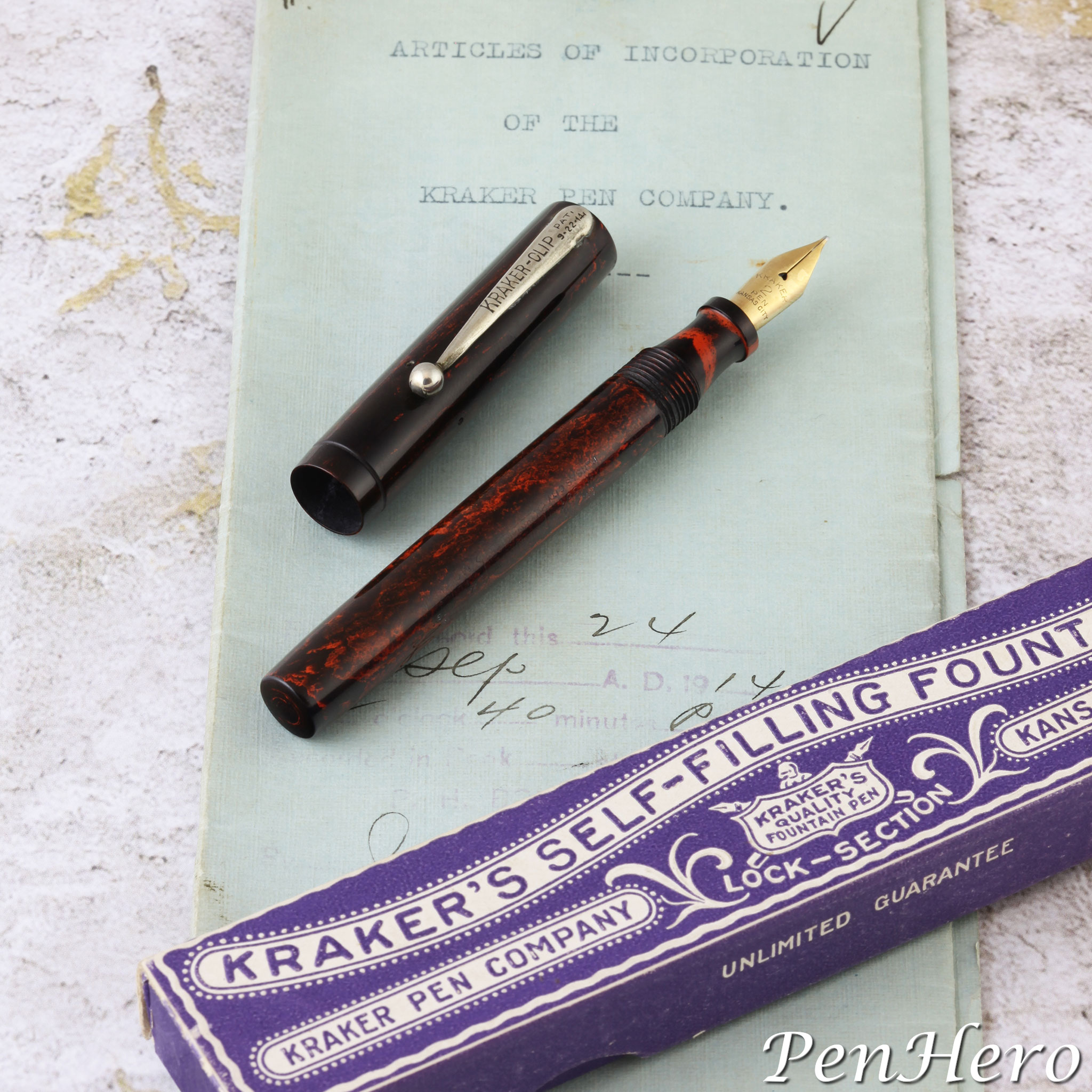 Kraker Number 2 fountain pen mottled 1914–1916
Kraker Number 2 fountain pen mottled 1914–1916
Kraker's quality fountain pen
The six Kraker fountain pens shown here were photographed for two articles that appeared in the spring and fall 2020 issues of the Pennant magazine, “The Beginning of the Kraker Pen Company” and “The Kraker Pen Company, Part II: Growth, Good Times, and Closure,” both by Nathaniel Harter. If you’re not a member of Pen Collectors of America, you’re missing out on a lot of great stories about writing instruments and the people and companies who made them.
A lot has been written about the short life of the Kraker Pen Company, George Kraker himself, the patent dispute with Sheaffer, and the sale of the company to Sheaffer. The articles referenced above and in the References section below offer more indepth coverage of the story. To set the table for this gallery article, I'll start with a short summary of the beginning and end of the Kraker Pen Company.
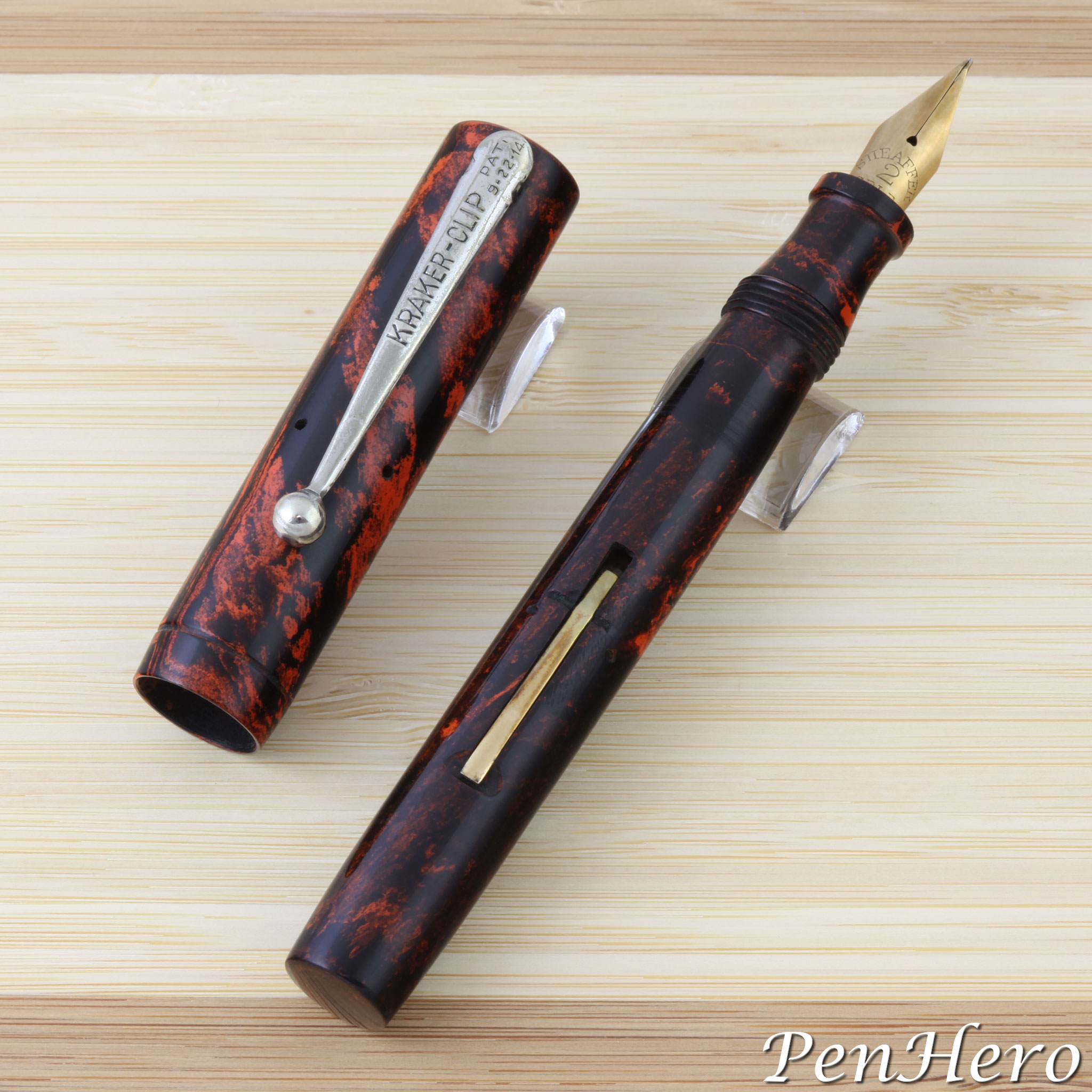 Kraker Number 2 fountain pen mottled 1914–1916 with Sheaffer nib
Kraker Number 2 fountain pen mottled 1914–1916 with Sheaffer nib
The Kraker Pen Company was incorporated on September 24, 1914 in Kansas City, Missouri with $15,000 in capital stock. The officers of the company were announced as Joseph A. Kraker, president, George Kraker’s brother, along with Harvey C. Craig and L. A. Blumenthal. A short article in the November 1915 Office Appliances reports that the Kraker Pen Company had just issued a twenty page catalog showing a range of small and medium fountain pens in short and long versions priced from $2.50 to $6.00. The catalog “describes the mechanism of the Kraker self-filling fountain pen, showing how the rubber ink tube is compressed by the pressure bar throughout its entire length when the pen is to be filled.” This mechanism would be the centerpiece of the dispute with the Sheaffer Pen Company. The company grew quickly, “increasing its capital stock from $50,000 to $100,000” in 1917 in order to increase its capacity to make fountain pens above the current 1,500 pens per day, an annual production of at least 390,000 pens considering 260 work days in a year. Kraker reported year over year sales were up 15 percent from 1916.
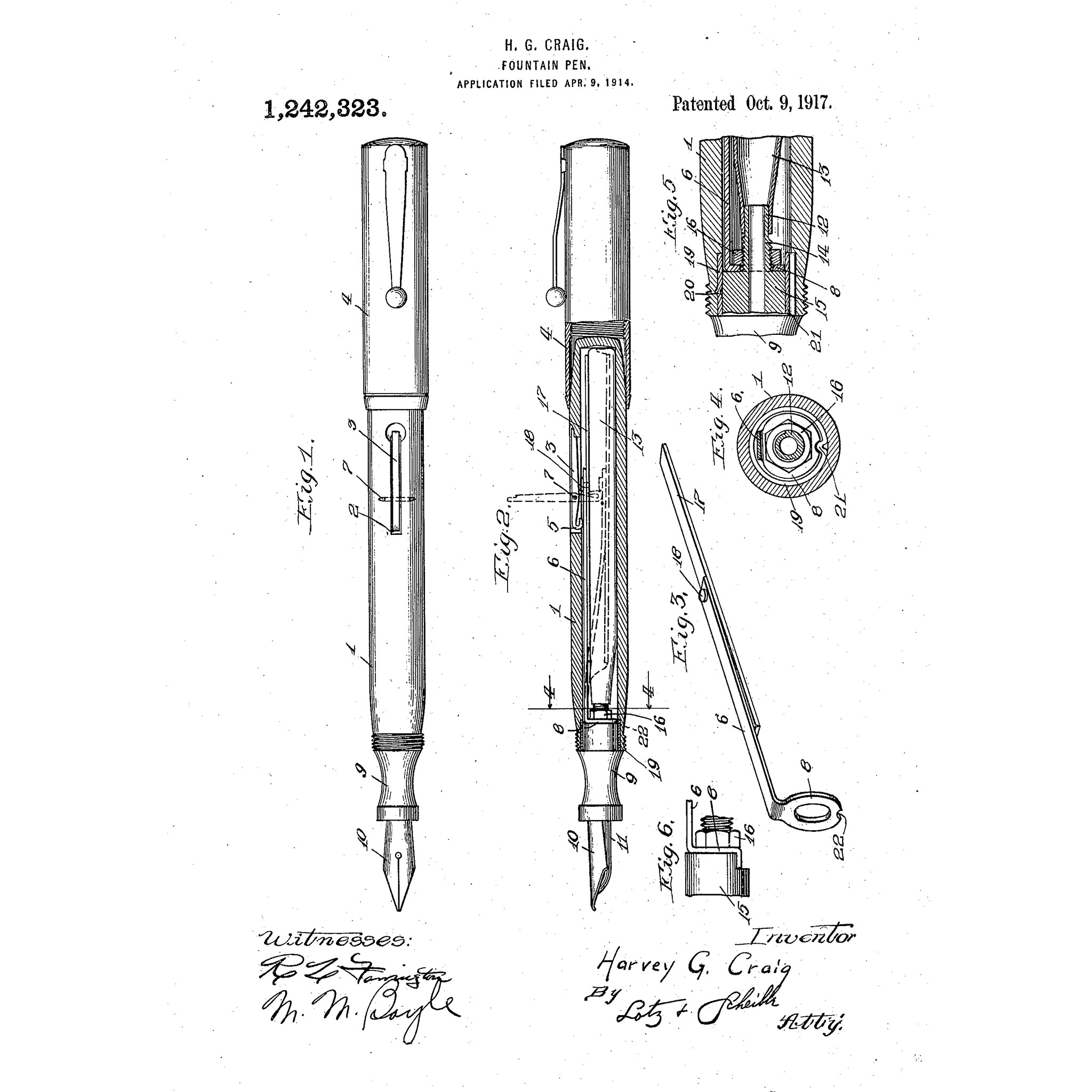 U. S. Patent 1,242,323, awarded to Harvey G. Craig, October 9, 1917
U. S. Patent 1,242,323, awarded to Harvey G. Craig, October 9, 1917
The pivotal event for the Kraker Pen Company was the fight with Sheaffer over who invented the double bar lever fill mechanism, Walter A. Sheaffer or Harvey C. Craig. This invention was a significant improvement over Sheaffer's original "single-bar" design. An unfavorable decision would be severely business impacting for either company. The patent interference claim brought by Harvey C. Craig against Sheaffer, "Patent Interference number 38392, Craig vs. Sheaffer, fountain pens" had its first hearing February 1, 1916. Craig's claim was that while he was working at Sheaffer he invented the double bar lever fill mechanism Sheaffer was using on the pens they manufactured. Sheaffer had already introduced the double bar invention on their pens by April 1913. The key to Sheaffer's patent and what they wanted to protect was "the combined spring and pressure bar." Sheaffer was awarded U. S. patent 1,118,240 for the double bar invention on November 24, 1914. This lever fill system was a key to Sheaffer’s early success and Sheaffer vigorously defended their patent.
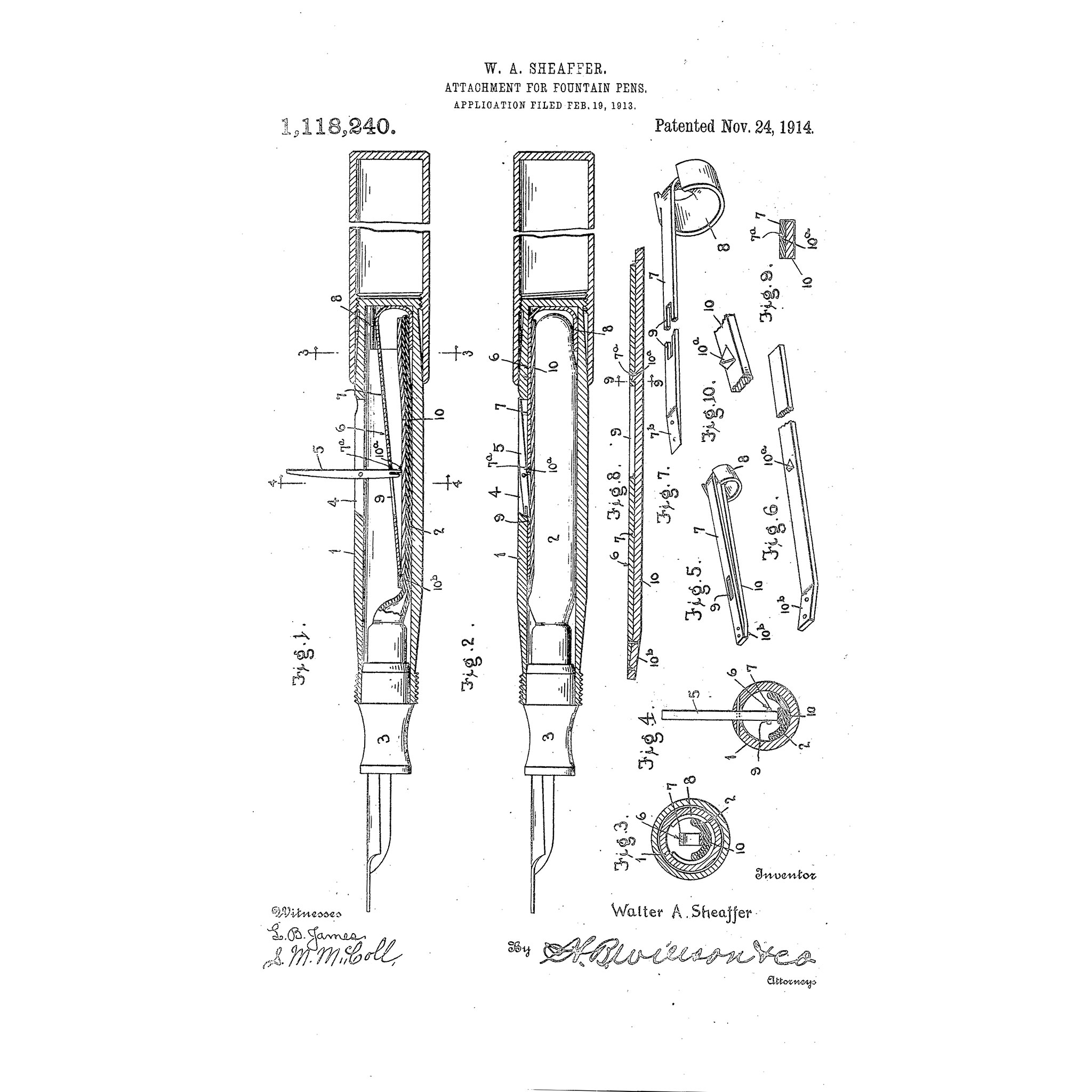 U. S. Patent 1,118,240, awarded to Walter A. Sheaffer, November 24, 1914
U. S. Patent 1,118,240, awarded to Walter A. Sheaffer, November 24, 1914
The Kraker Pen Company backed Craig's claim as they would be the assignee of Craig's patent, were making fountain pens with the Craig double bar design, and their production and sales would be at risk if they lost control of that essential functional element. A key weakness in Craig's argument for priority of his patent application was his waiting over a year, until April 9, 1914, to file his patent application knowing W. A. Sheaffer had filed for his double bar invention on February 19, 1913 and that Craig raised no objection or defense at the time and until filing his patent interference claim. It didn't help that Sheaffer had already made over 200,000 pens using the patented invention before Craig's claim.
Sheaffer won, and Sheaffer’s patent was given priority over the Craig patent, 1,242,323, which was awarded later on October 9, 1917. The decision favoring Sheaffer by H. E. Stauffer, Examiner of Interferences, was given August 22, 1916. In 1917, in a separate case, Walter A. Sheaffer vs. C.E. Barrett, future baseball commissioner United States District Court Justice Kenesaw Mountain Landis, issued an injunction forbidding the Kraker Pen Company and C. E. Barrett, a Kraker supplier, from “making, selling, or assembling and parts relating to” Sheaffer’s patent. This would bring a halt to any Kraker production of pens using Craig's double bar lever fill patent design. The W. A. Sheaffer Pen Company acquired the Kraker Pen Company for $1.00 on February 19, 1918.
Early Kraker fountain pen models
An advertisement by a Kraker retailer in the November 24, 1917 Gospel Messenger lists five models of Kraker fountain pens with prices as follows:
Model Number Price No. 2 or 2S $2.50 No. 3 or 3S $3.00 No. 34 or 34S $3.50 No. 4 or 4S $4.00 No. 5 or 5S $5.00
The customer had a choice of holder size, holder finish, whether or not to have a pocket clip, and the type of nib.
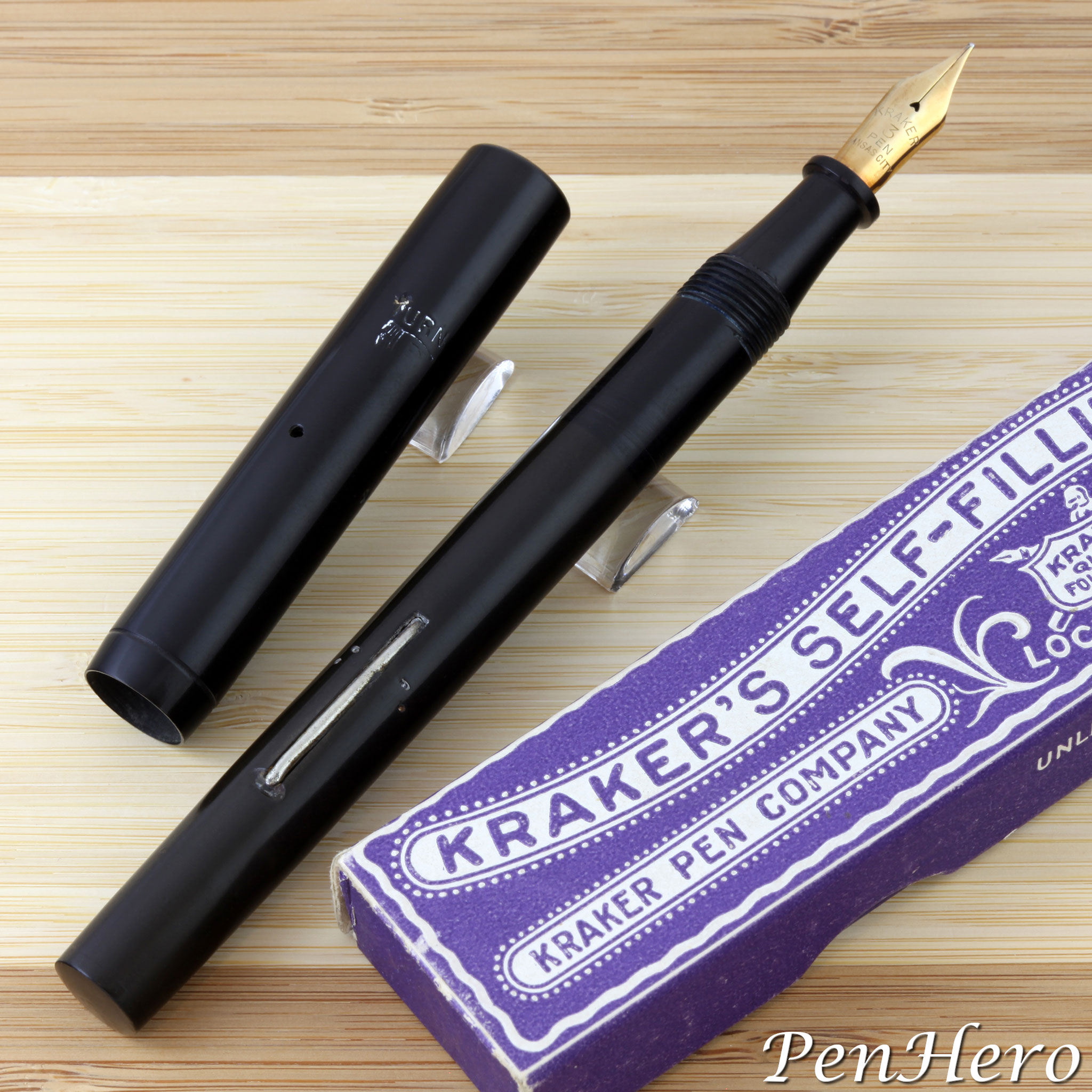 Kraker Number 3 fountain pen black 1914–1916
Kraker Number 3 fountain pen black 1914–1916
The ‘S’ in the model name indicates a short holder of the same barrel and nib size at the same price. Customers would then have a choice of three hard rubber finishes: black, chased black, or mottled (red and black) holders. German Silver clips were optional at 25 cents additional and were stamped KRAKER-CLIP and PAT 9-22-14, indicating Kraker patent 1,111,501 for a pen clip. Finally, there was a choice of twelve types of 14 karat gold nibs, called pens at the time: extra fine, fine, medium, coarse (broad), manifold, stub, left oblique, falcon, turned up, posting, bookkeeper’s, and stenographer’s. The advertisement described the nibs as hand tempered and iridium tipped.
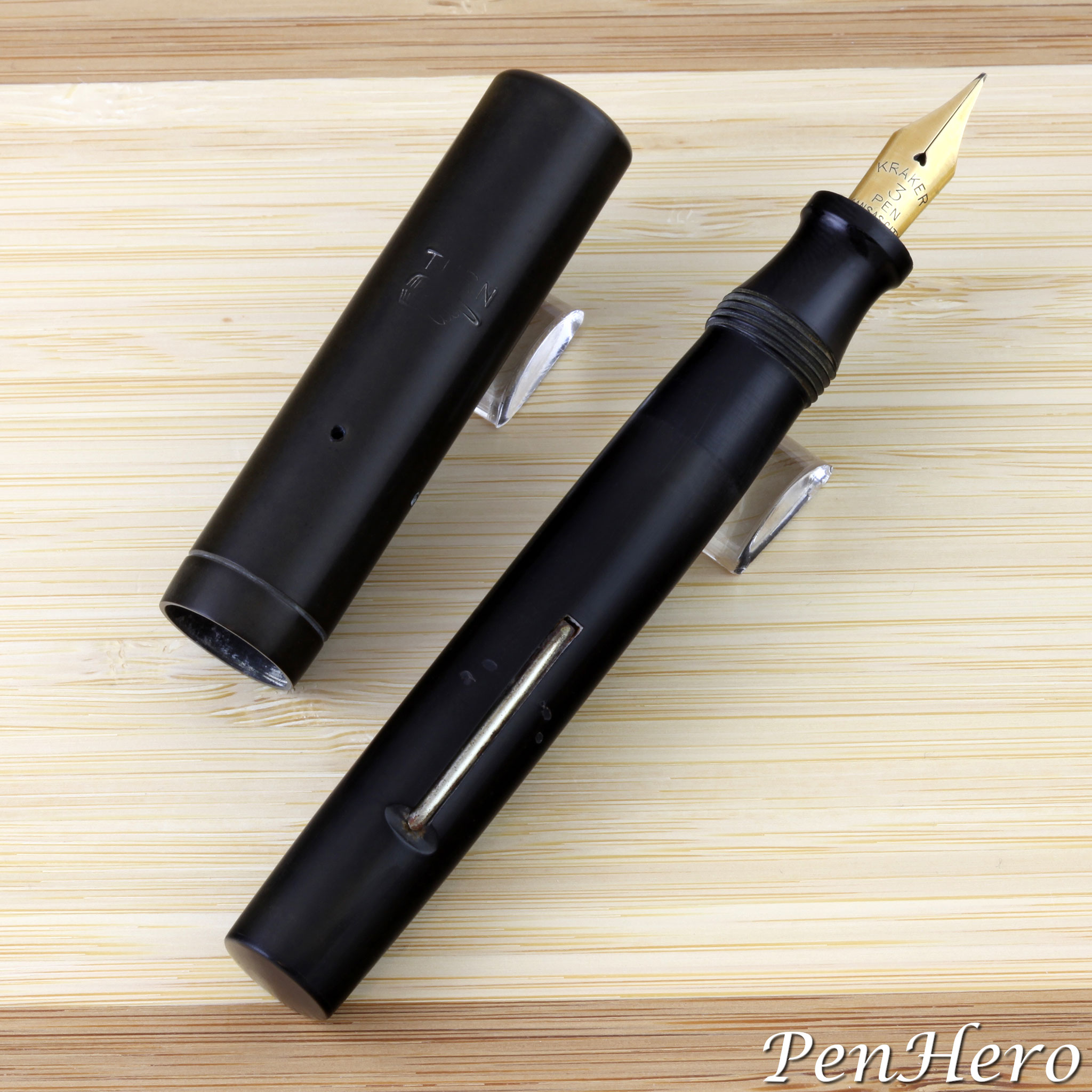 Kraker Number 4 fountain pen black 1914-1916 with No. 3 nib
Kraker Number 4 fountain pen black 1914-1916 with No. 3 nib
Kraker put some thought into how the user would interact with the threaded cap as many pens available at the time had slip on caps. The cap is stamped TURN with a pointing hand to indicate the direction to twist to remove the cap.
The early (1914-1916) barrel imprint is PAT NO over 1111463 over 1111501 over KANSAS CITY next to the Kraker logo next to OTHER over PATENTS over PENG. over MO. U.S.A. See the two center pens below.
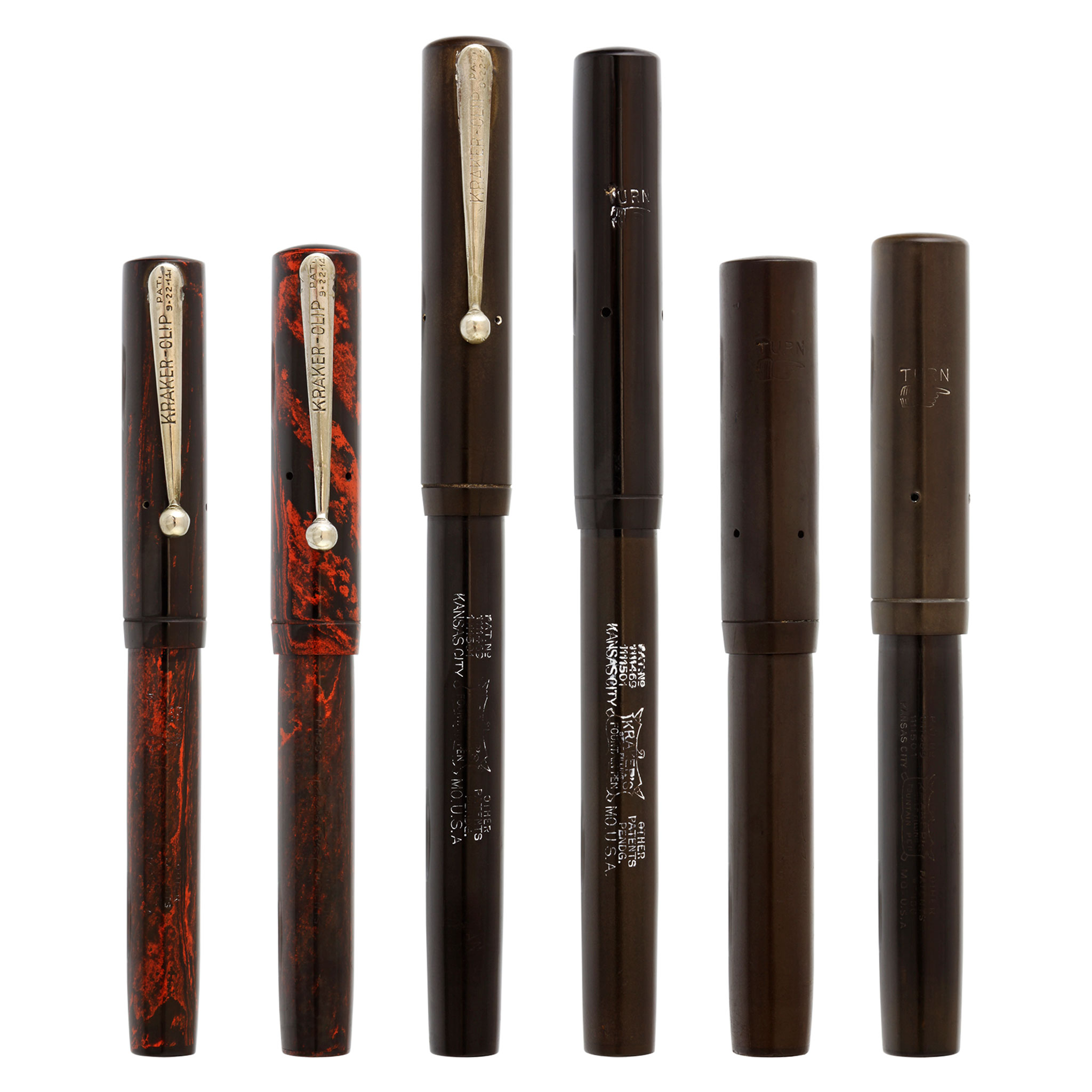 Kraker fountain pens, left to right,two Number 2 mottled, two Number 3 black, and two Number 4 Short black 1914-1916
Kraker fountain pens, left to right,two Number 2 mottled, two Number 3 black, and two Number 4 Short black 1914-1916
The following is a gallery of select early Kraker fountain pens from 1914-1916 with some basic identification information. There are other Kraker models from this period that were unavailable to photograph.
Kraker Number 2
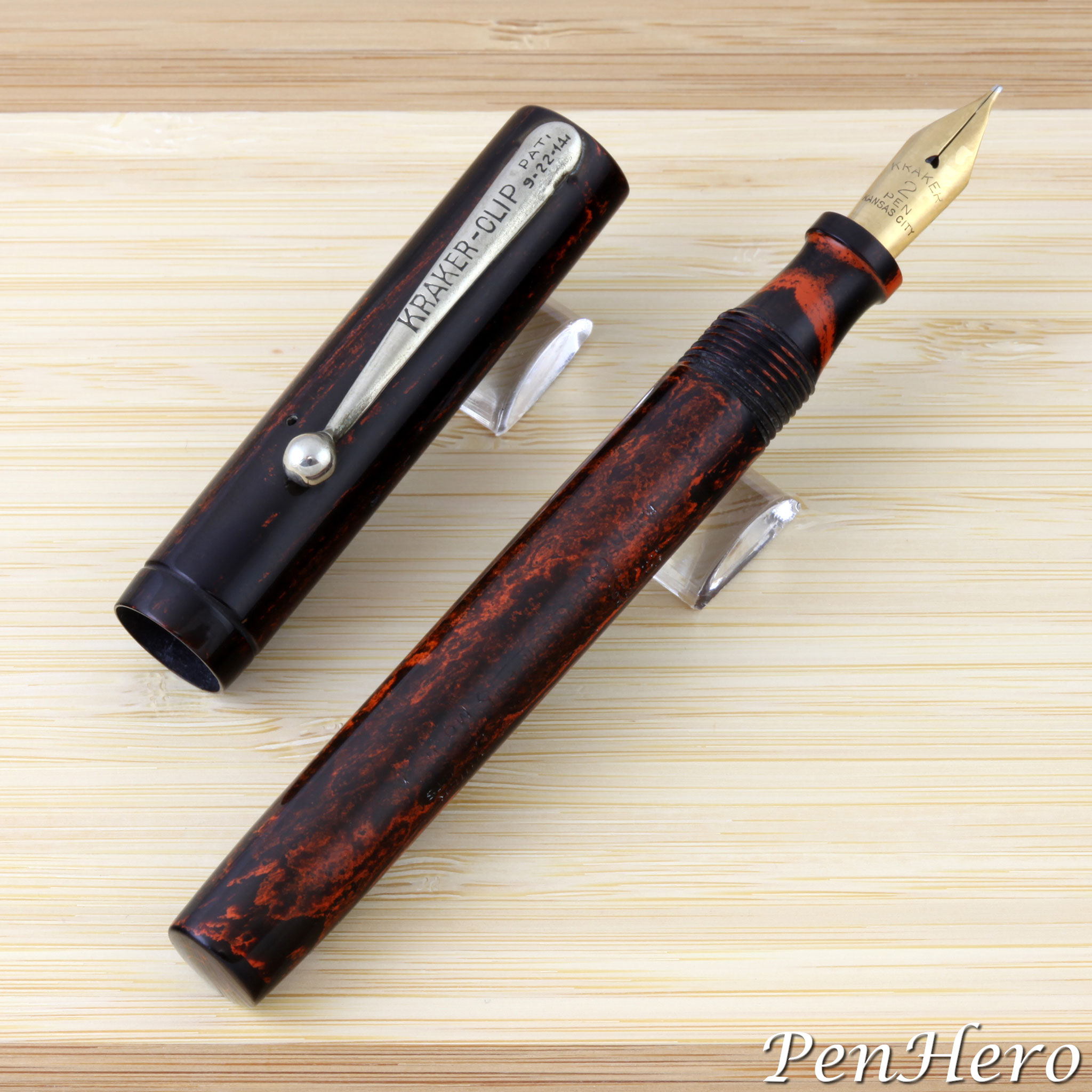 Kraker Number 2 fountain pen mottled 1914-1916
Kraker Number 2 fountain pen mottled 1914-1916
Although identified to me as a Number 2, I wonder if this is actually a Number 2 Short, given it is about the same length as the Number 4 Short below.
- About 109-111mm long capped
- Retail price: $2.50
- 14 karat gold nib stamped KRAKER over 2 over PEN over KANSAS CITY
- Black, chased black, or mottled (red and black) holder
- Packaged in a paperboard box
Kraker Number 3
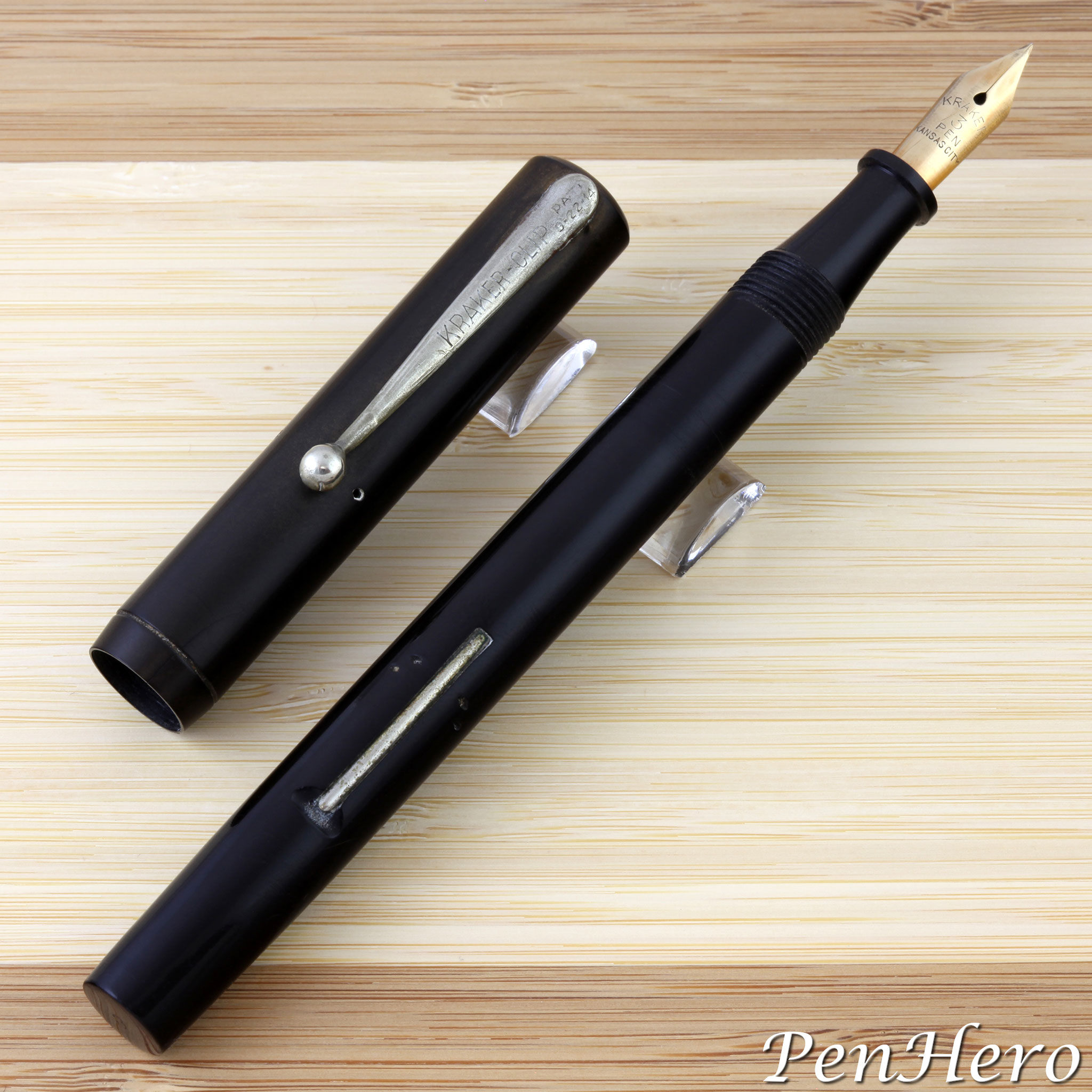 Kraker Number 3 fountain pen black 1914-1916
Kraker Number 3 fountain pen black 1914-1916
- About 138-140mm long capped
- Retail price: $3.00
- 14 karat gold nib stamped KRAKER over 3 over PEN over KANSAS CITY
- Black, chased black, or mottled (red and black) holder
- Packaged in a paperboard box
Kraker Number 4 Short
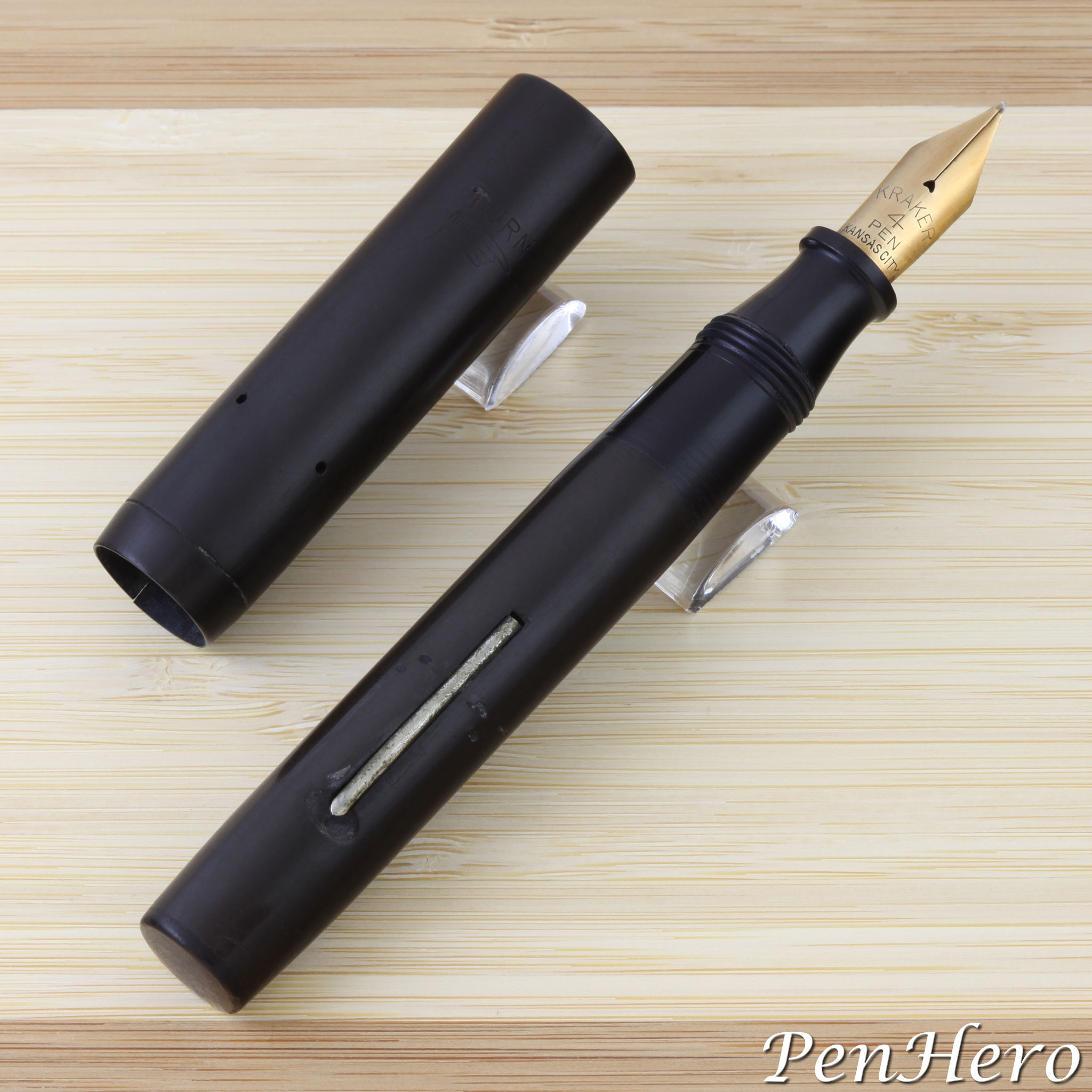 Kraker Number 4 Short fountain pen black 1914-1916
Kraker Number 4 Short fountain pen black 1914-1916
- About 109-112mm long capped
- Retail price: $4.00
- 14 karat gold nib stamped KRAKER over 4 over PEN over KANSAS CITY
- Black, chased black, or mottled (red and black) holder
- Packaged in a paperboard box
Several Sheaffer collectors focus on Kraker fountain pens as they represent part of the early story of the W. A. Sheaffer Pen Company. Collecting them is a challenge and they can be moderately expensive, especially the mottled ones. Original pen boxes and other ephemera are especially prized.
Pennant Spring and Fall 2020
If the reader would like to know more about the Kraker Pen Company and its relationship with the Sheaffer Pen Company, I recommend “The Beginning of the Kraker Pen Company” and “The Kraker Pen Company, Part II: Growth, Good Times, and Closure,” both by Nathaniel Harter and in the spring and fall 2020 issues of the Pennant, the magazine of the Pen Collectors of America. The pens shown above were photographed for those articles.
References
Advertisement, The Gospel Messenger, November 24, 1917, page 760
“Catalogues” Office Appliances, November 1915, page 164
“Excerpts From Decision in Sheaffer Interference Case in Patent Office” Geyer's Stationer, August 31, 1916, page 12
“Interlocutory Decree in Fountain Pen Case” Office Appliances, June 1917, page 29
“Miscellaneous Factories” Industrial Development and Manufacturers Record, October 1,1914, page 65
“New Evidence for the Early History of the Sheaffer Pen Company: Introduction & Notes [2001]” by David Nishimura, The Vintage Pens website, Copyright © 2001-2003 David Nishimura
“New Evidence for the Early History of the Sheaffer Pen Company: The First Sheaffer Pens (First in a Series)” by David Nishimura, The Vintage Pens website, Copyright © 2001-2003 David Nishimura
“Patents” Office Appliances, October 1914, page 138
“Pens and Pencils” Office Appliances, May 1917, page 190
“The Beginning of the Kraker Pen Company” by Nathaniel Harter The Pennant, the magazine of the Pen Collectors of America spring 2020, pages 11-16
“The Kraker Pen Company, Part II: Growth, Good Times, and Closure” by Nathaniel Harter The Pennant, the magazine of the Pen Collectors of America fall 2020, pages 20-23
U. S. Patent 778,407, awarded to Charles A. Faber, December 27, 1904
U. S. Patent 1,111,469, awarded to George M. Kraker, September 22, 1914
U. S. Patent 1,111,501, awarded to Albert Scheible, September 22, 1914
U. S. Patent 1,118,240, awarded to Walter A. Sheaffer, November 24, 1914
U. S. Patent 1,164,654, awarded to George M. Kraker, December 21, 1915
U. S. Patent 1,242,323, awarded to Harvey G. Craig, October 9, 1917
Interact
Comments on this article may be sent to the author, Jim Mamoulides


